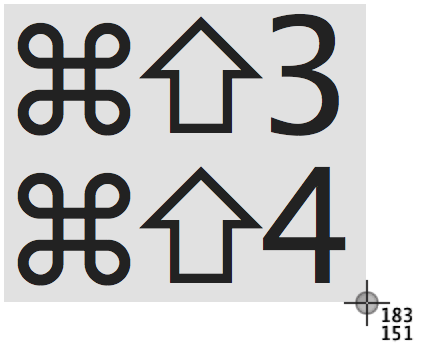Did you ever want to capture a picture of what’s on your screen, or at least a part of it? Screenshots aren’t just for technical writers trying to document app behavior—you might also use them to provide feedback on a photo, to document an error message for someone who helps you with your Mac, or to record a particularly funny auto-correct fail in Messages on your iPhone.
macOS and iOS have both long included built-in screenshot features that make it easy to take a high-resolution picture of what you see onscreen. (You can, of course, use a camera to take a photo of your screen, but that will never look as good.)
Taking a screenshot in iOS is super simple, and it works the same on an iPhone, iPad, or iPod touch. Just press the Home and Sleep/Wake buttons simultaneously. The screen flashes, and iOS saves the screenshot to your Photos app—look at the bottom of the Photos collection or, if you’ve turned on iCloud Photo Library, the All Photos album.
The same technique works on the Apple Watch, where you press both the digital crown and the side button simultaneously. (Accidental presses of those buttons explains why random Apple Watch screenshots might appear in Photos.)
On the Mac, you can take your pick from three built-in methods of taking screenshots:
 If you take a lot of screenshots, consider memorizing macOS’s keyboard shortcuts. For a full-screen screenshot, press Command-Shift-3. For a screenshot of an arbitrary size, press Command-Shift-4 and drag out a rectangle. To capture just an object like a window, press Command-Shift-4, hover the pointer over the window, press the Space bar to show the camera cursor over the highlighted object, and then click to take the screenshot.
If you take a lot of screenshots, consider memorizing macOS’s keyboard shortcuts. For a full-screen screenshot, press Command-Shift-3. For a screenshot of an arbitrary size, press Command-Shift-4 and drag out a rectangle. To capture just an object like a window, press Command-Shift-4, hover the pointer over the window, press the Space bar to show the camera cursor over the highlighted object, and then click to take the screenshot.
A few notes:
- The Command-Shift-4 shortcut is the only way to capture a menu.
- On a MacBook Pro with a Touch Bar, after you press Command-Shift-4, notice the helpful buttons on the Touch Bar.
- All screenshots are saved as PNG files on your Desktop and named with the date.
![]() If those keyboard shortcuts sound hard to remember, try Apple’s Grab app, which is hidden away in the Utilities folder inside your Applications folder. It’s a simple app, but it can take full-screen, window, and selection screenshots, and it walks you through the process. You can also use Grab to capture a full-screen screenshot with a timer, which is handy if what you want to record appears only while you’re dragging an icon or another object, for instance. Captured screenshots appear in Grab as Untitled TIFF documents that you can close, copy, save, or print.
If those keyboard shortcuts sound hard to remember, try Apple’s Grab app, which is hidden away in the Utilities folder inside your Applications folder. It’s a simple app, but it can take full-screen, window, and selection screenshots, and it walks you through the process. You can also use Grab to capture a full-screen screenshot with a timer, which is handy if what you want to record appears only while you’re dragging an icon or another object, for instance. Captured screenshots appear in Grab as Untitled TIFF documents that you can close, copy, save, or print.
![]() Want to mark up a screenshot with circles and arrows and a paragraph of text? For that, use Apple’s surprisingly powerful Preview app, which takes screenshots as editable graphic documents. Choose File > Take Screenshot > From Selection, From Window, or From Entire Screen. That last option takes a timed screenshot so you can set up any temporary conditions while the timer counts down. It’s the only way to capture the pointer in a screenshot. To access the tools you need to add shapes or text to your screenshot, choose View > Show Markup Toolbar. When you’re done, you can save the screenshot in a variety of formats. For more about what you can do with Preview, read Take Control of Preview.
Want to mark up a screenshot with circles and arrows and a paragraph of text? For that, use Apple’s surprisingly powerful Preview app, which takes screenshots as editable graphic documents. Choose File > Take Screenshot > From Selection, From Window, or From Entire Screen. That last option takes a timed screenshot so you can set up any temporary conditions while the timer counts down. It’s the only way to capture the pointer in a screenshot. To access the tools you need to add shapes or text to your screenshot, choose View > Show Markup Toolbar. When you’re done, you can save the screenshot in a variety of formats. For more about what you can do with Preview, read Take Control of Preview.
You can also take screenshots using a cornucopia of third-party screenshot utilities. In general, they don’t offer much more than Apple’s options when it comes to capturing screenshots. Where they stand out is providing better tools for marking up and manipulating screenshots, and in offering an interface for managing and sharing screenshots. Choosing among them is largely a matter of personal preference, but check out Evernote’s free Skitch, the free Monosnap, and Global Delight’s $29.99 Capto.
Whatever method you choose, remember that a picture may be worth a thousand words, but the right screenshot is even more valuable.
Twitter: “A picture is worth a thousand words.” Learn how to take screenshots on your Mac, iPad, and iPhone on our site at:
Facebook: A picture may be worth a thousand words, but a screenshot that captures a confusing error message is far more valuable. Pop over to our site, and we’ll explain how to capture screenshots on your iPhone or iPad, and three different ways you can take screenshots on your Mac.





